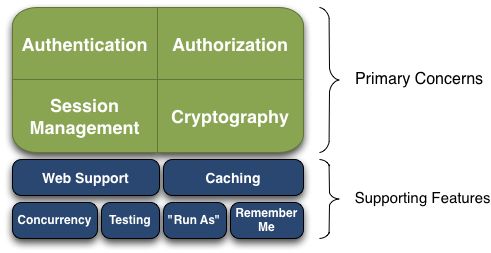shiro(1)-简介
简介
apache shiro 是一个功能强大和易于使用的Java安全框架,为开发人员提供一个直观而全面的的解决方案的认证,授权,加密,会话管理。
在实际应用中,它实现了应用程序的安全管理的各个方面。
shiro的功能

apache shiro能做什么?
支持认证跨一个或多个数据源(LDAP,JDBC,kerberos身份等)
执行授权,基于角色的细粒度的权限控制。
增强的缓存的支持。
支持web或者非web环境,可以在任何单点登录(SSO)或集群分布式会话中使用。
主要功能是:认证,授权,会话管理和加密。
下载并且使用
1,确保系统内安装JDK1.5+和maven2.2+。
2,到shiro主页下载shiro.
3,解压缩
unzip shiro-root-1.1.0-source-release.zip
4,进入到quickstart目录
cd shiro-root-1.1.0/samples/quickstart
5,运行quickstart
mvn compile exec:java
执行完成如下图:

Quickstart.java
// get the currently executing user: Subject currentUser = SecurityUtils.getSubject();
使用SecurityUtils.getSubject(),我们可以得到当前正在执行的主题。
得到主题之后,你可以得到他对应的会话信息
// Do some stuff with a Session (no need for a web or EJB container!!!)
Session session = currentUser.getSession();
session.setAttribute("someKey", "aValue");
String value = (String) session.getAttribute("someKey");
if (value.equals("aValue")) {
log.info("Retrieved the correct value! [" + value + "]");
}
你可以得到http的session信息,也可以在非web环境中使用,得到相对应的会话信息。
如果在web应用程序中部署应用,默认情况下,应用将以HttpSession为基础。在企业级应用中,你在多个应用中可以使用相同的API,无论部署环境。而且使用任何客户端技术你都可以共享会话数据。
接下来判断登录信息
// let's login the current user so we can check against roles and permissions:
if (!currentUser.isAuthenticated()) {
UsernamePasswordToken token = new UsernamePasswordToken("lonestarr", "vespa");
token.setRememberMe(true);
try {
currentUser.login(token);
} catch (UnknownAccountException uae) {
log.info("There is no user with username of " + token.getPrincipal());
} catch (IncorrectCredentialsException ice) {
log.info("Password for account " + token.getPrincipal() + " was incorrect!");
} catch (LockedAccountException lae) {
log.info("The account for username " + token.getPrincipal() + " is locked. " +
"Please contact your administrator to unlock it.");
}
// ... catch more exceptions here (maybe custom ones specific to your application?
catch (AuthenticationException ae) {
//unexpected condition? error?
}
}
如果正确可以向下执行,如果不正确,就会对不同的业务进行处理。
比如用户名不正确,密码不正确,用户被锁定的异常,当然也可以使用自定义抛出的异常。
如果登录成功,那么下一步可以做什么呢?
提示当前用户:
//say who they are:
//print their identifying principal (in this case, a username):
log.info("User [" + currentUser.getPrincipal() + "] logged in successfully.");
接着测试是否还有其它角色
//test a role:
if (currentUser.hasRole("schwartz")) {
log.info("May the Schwartz be with you!");
} else {
log.info("Hello, mere mortal.");
}
接着测试是否有特定的权限
//test a typed permission (not instance-level)
if (currentUser.isPermitted("lightsaber:weild")) {
log.info("You may use a lightsaber ring. Use it wisely.");
} else {
log.info("Sorry, lightsaber rings are for schwartz masters only.");
}
接着验证一个非常强大的实例级权限
//a (very powerful) Instance Level permission:
if (currentUser.isPermitted("winnebago:drive:eagle5")) {
log.info("You are permitted to 'drive' the winnebago with license plate (id) 'eagle5'. " +
"Here are the keys - have fun!");
} else {
log.info("Sorry, you aren't allowed to drive the 'eagle5' winnebago!");
}
最后是使用程序注销:
//all done - log out!
currentUser.logout();